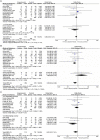The effect of vitamin C in adults with sepsis: a meta-analysis of randomized controlled trials
- PMID: 37720500
- PMCID: PMC10502229
- DOI: 10.3389/fmed.2023.1244484
The effect of vitamin C in adults with sepsis: a meta-analysis of randomized controlled trials
Abstract
Background: The effect of intravenous (IV) vitamin C in the treatment of sepsis remains controversial. We aimed to explore the clinical efficacy of vitamin C in the treatment of sepsis.
Methods: Electronic databases (PubMed, Embase, Web of Science, and Cochrane Library) were searched from inception through November 15th, 2022, for randomized controlled trials evaluating the effect of IV vitamin C treatment in patients with sepsis. The primary outcome was short-term mortality, secondary outcomes included duration of vasopressor use, length of intensive care unit (ICU) stay, and Sequential Organ Failure Assessment (SOFA) score after vitamin C treatment. Subgroup analyses were performed based on the dose and duration of IV vitamin C and region to determine whether vitamin C benefited patients with sepsis.
Results: A total of 10 studies including 1,426 patients fulfilled the predefined criteria and were analyzed. Overall, there were no significant differences between the vitamin C group and the control group regarding short-term mortality [odds ratio (OR), 0.61; 95% confidence interval (CI) 0.37-1.01; p = 0.05], ICU length of stay [mean difference (MD), -1.24; 95% CI -3.54 to 1.05, p = 0.29] and SOFA score (MD, -0.85, 95% CI -2.38 to 0.67, p = 0.27). However, vitamin C significantly reduced the duration of vasopressor use (MD, -14.36, 95% CI -26.11 to -2.61, p = 0.02). Furthermore, subgroup analysis found that in developing countries, vitamin C was associated with a significant reduction in short-term mortality (OR, 0.33; 95% CI 0.12-0.90; p = 0.03), duration of vasopressor use (MD, -24.37, 95% CI -33.72 to -15.02, p < 0.001) and SOFA score (MD, -2.55, 95% CI -4.81 to -0.28, p = 0.03).
Conclusion: In our study, vitamin C administration for sepsis patients was not associated with a significant reduction in short-term mortality, length of ICU stay or SOFA score. However, we observed that vitamin C could reduce the duration of vasopressor use. Furthermore, sepsis patients in developing countries may benefit more from vitamin C administration than those in developed countries.Systematic review registration: Identifier CRD42022380958, https://www.crd.york.ac.uk/PROSPERO/display_record.php?RecordID=380958.
Keywords: meta-analysis; mortality; sepsis; treatment; vitamin C.
Copyright © 2023 Luo, Zhu, Zhang, Zhu, Kuang, Shao, Guo and Ning.
Conflict of interest statement
The authors declare that the research was conducted in the absence of any commercial or financial relationships that could be construed as a potential conflict of interest.
Figures





Similar articles
-
The effect of intravenous vitamin C on clinical outcomes in patients with sepsis or septic shock: A meta-analysis of randomized controlled trials.Front Nutr. 2022 Jul 28;9:964484. doi: 10.3389/fnut.2022.964484. eCollection 2022. Front Nutr. 2022. PMID: 35967816 Free PMC article.
-
Effect of Combined Hydrocortisone, Ascorbic Acid and Thiamine for Patients with Sepsis and Septic Shock: A Systematic Review and Meta-Analysis.Shock. 2021 Dec 1;56(6):880-889. doi: 10.1097/SHK.0000000000001781. Shock. 2021. PMID: 34529397
-
The outcome of IV vitamin C therapy in patients with sepsis or septic shock: a meta-analysis of randomized controlled trials.Crit Care. 2023 Mar 13;27(1):109. doi: 10.1186/s13054-023-04392-y. Crit Care. 2023. PMID: 36915173 Free PMC article.
-
[Therapeutic effect of hydrocortisone combined with vitamin C and vitamin B1 on patients with sepsis: a Meta-analysis].Zhonghua Wei Zhong Bing Ji Jiu Yi Xue. 2021 Sep;33(9):1040-1046. doi: 10.3760/cma.j.cn121430-20210728-01101. Zhonghua Wei Zhong Bing Ji Jiu Yi Xue. 2021. PMID: 34839858 Chinese.
-
A Systematic Review and Meta-Analysis on Possible Role of Vitamin C in Sepsis.Cureus. 2022 Dec 23;14(12):e32886. doi: 10.7759/cureus.32886. eCollection 2022 Dec. Cureus. 2022. PMID: 36699754 Free PMC article. Review.
Cited by
-
A Comparison of the Efficacy of High-Dose Vitamin C Infusion and Thiamine (Vitamin B1) Infusion in Patients With Sepsis: A Prospective Randomized Controlled Trial.Cureus. 2024 Dec 7;16(12):e75296. doi: 10.7759/cureus.75296. eCollection 2024 Dec. Cureus. 2024. PMID: 39776708 Free PMC article.
-
Global emergency medicine: A scoping review of the literature from 2023.Acad Emerg Med. 2025 May;32(5):553-569. doi: 10.1111/acem.70012. Epub 2025 Mar 7. Acad Emerg Med. 2025. PMID: 40052382 Free PMC article.
-
Vitamin C improves 28-day survival in patients with sepsis-associated acute kidney injury in the intensive care unit: a retrospective study.Front Nutr. 2025 Jun 5;12:1600224. doi: 10.3389/fnut.2025.1600224. eCollection 2025. Front Nutr. 2025. PMID: 40538589 Free PMC article.
References
Publication types
LinkOut - more resources
Full Text Sources

